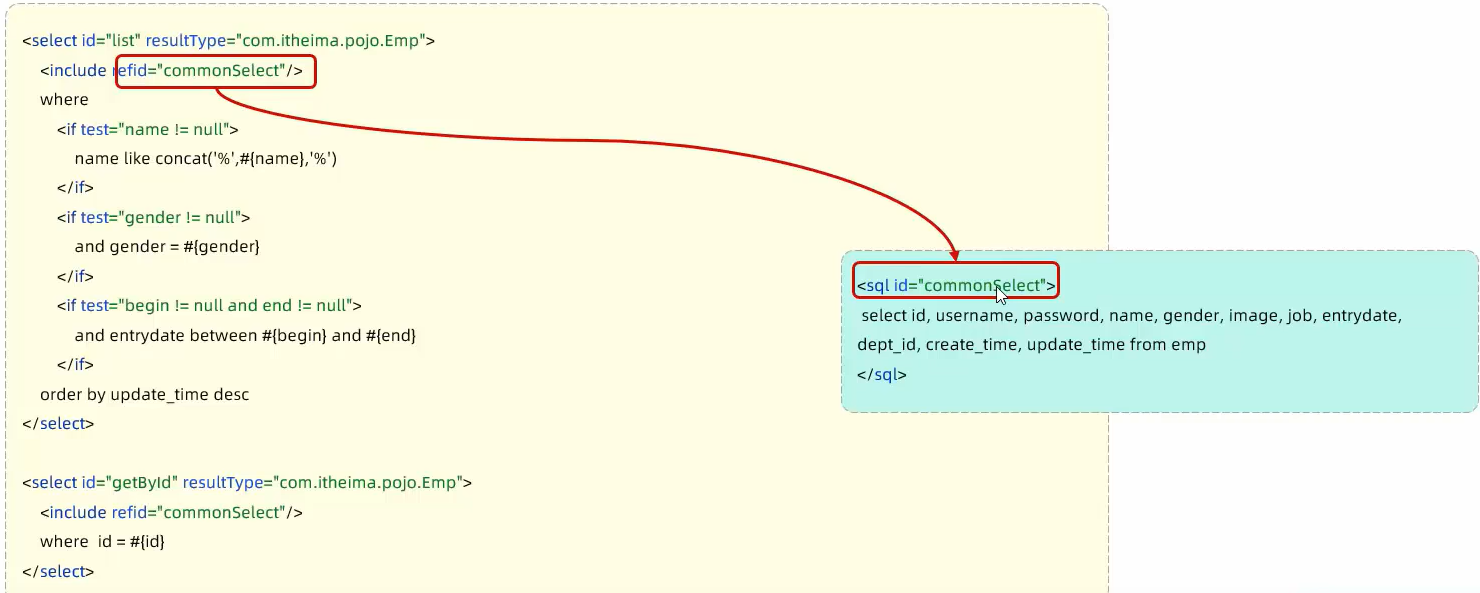java_web入门第5天
多表查询
概述
- 多表查询: 指从多张表中查询数据
- 笛卡尔积: 笛卡尔乘积是指在数学中,两个集合(A 集合 和 B 集合)的所有组合情况。(在多表查询时,需要消除无效的笛卡尔积)

分类
- 连接查询
- 内连接:相当于查询 A、B 交集部分数据
- 外连接
- 左外连接:查询左表所有数据(包括两张表交集部分数据)
- 右外连接:查询右表所有数据(包括两张表交集部分数据)
- 子查询
内连接
语法:
- 隐式内连接:
select 字段列表 from 表1 , 表2 where 条件 ...; - 显式内连接:
select 字段列表 from 表1 [ inner ] join 表2 on 连接条件 ...;
外连接
语法:
- 左外连接:
select 字段列表 from 表1 left [ outer ] join 表2 on 连接条件 ... ; - 右外连接:
select 字段列表 from 表1 right [ outer ] join 表2 on 连接条件 ... ;
子查询
- 概述
- 介绍:SQL 语句中嵌�套 select 语句,称为嵌套查询,又称子查询。
- 形式:
select * from t1 where column1 = ( select column1 from t2 … ); - 子查询外部的语句可以是
insert / update / delete / select的任何一个,最常见的是select。
- 分类
- 标量子查询:子查询返回的结果为单个值
- 列子查询:子查询返回的结果为一列
- 行子查询:子查询返回的结果为一行
- 表子查询:子查询返回的结果为多行多列
- 标量子查询
- 子查询返回的结果是单个值(数字、字符串、日期等),最简单的形式
- 常用的操作符:= <> > >= < <=
- 列子查询
- 子查询返回的结果是一列(可以是多行)
- 常用的操作符:
in 、not in等
- 行子查询
- 子查询返回的结果是一行(可以是多列)。
- 常用的操作符:
= 、<> 、in 、not in
- 表子查询
- 子查询返回的结果是多行多列,常作为临时表
- 常用的操作符:
in
事务
介绍 & 操作
- 概念:事务 是一组操作的集合,它是一个不可分割的工作单位。事务会把所有的操作作为一个整体一起向系统提交或撤销操作请求,即这些操作 要么同时成功,要么同时失败。
- 注意事项: 默认 MySQL 的事务是自动提交的,也就是�说,当执行一条 DML 语句,MySQL 会立即隐式的提交事务。
- 操作
- 开启事务:
start transaction; / begin ; - 提交事务:
commit; - 回滚事务:
rollback;
- 开启事务:
四大特性
四大特性(ACID)
- 原子性(Atomicity):事务是不可分割的最小单元,要么全部成功,要么全部失败
- 一致性(Consistency):事务完成时,必须使所有的数据都保持一致状态
- 隔离性(Isolation):数据库系统提供的隔离机制,保证事务在不受外部并发操作影响的独立环境下运行
- 持久性(Durability):事务一旦提交或回滚,它对数据库中的数据的改变就是永久的
索引
介绍
索引(index)是帮助数据库 高效获取数据 的 数据结构 。
优缺点:
- 优点
- 提高数据查询的效率,降低数据库的 IO 成本。
- 通过索引列对数据进行排序,降低数据排序的成本,降低 CPU 消耗。
- 缺点
- 索引会占用存储空间。
- 索引大大提高了查询效率,同时却也降低了
insert、update、delete的效率。
结构
MySQL 数据库支持的索引结构有很多,如:Hash 索引、B+Tree 索引、Full-Text 索引等。我们平常所说的索引,如果没有特别指明,都是指默认的 B+Tree 结构组织的索引。
- 大数据量情况下,二叉树、红黑树层级深,检索速度慢。
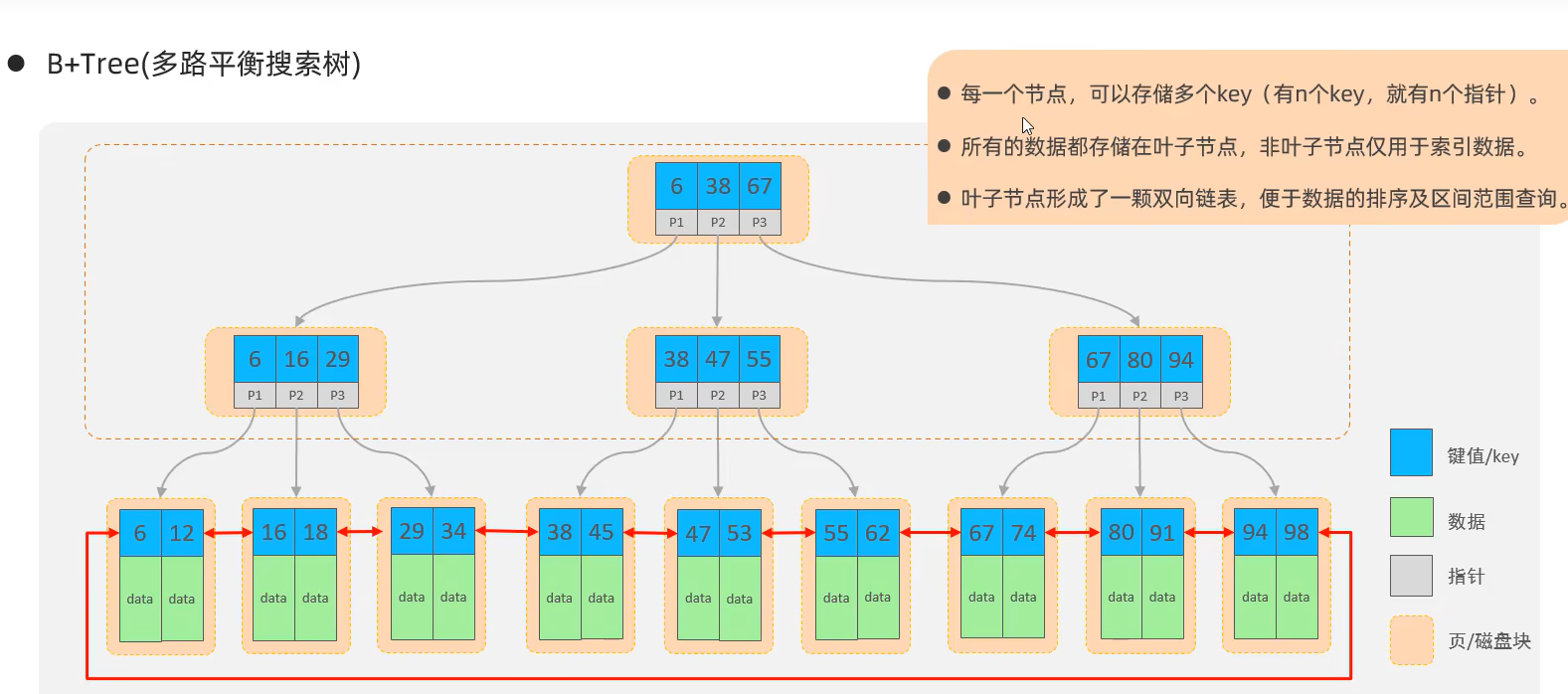
语法
- 创建索引:
create [ unique ] index 索引名 on 表名 (字段名,... ) ; - 查看索引:
show index from 表名; - 删除索引:
drop index 索引名 on 表名; - 注意事项:
- 主键字段,在建表时,会自动创建主键索引。
- 添加唯一约束时,数据库实际上会添加唯一索引。
第 5 章 MyBatis
- MyBatis是一款优秀的 持久层(dao 层) 框架,用于简化 JDBC 的开发。
- MyBatis 本是 Apache 的一个开源项目 iBatis, 2010 年这个项目由 apache 迁移到了 google code,并且改名为 MyBatis 。2013 年 11 月迁移到 Github。
- 官网:https://mybatis.org/mybatis-3/zh/index.html
Mybatis入门
快速入门
- 准备工作(创建 springboot 工程、数据库表 user、实体类User)
- 引入 Mybatis 的相关依赖,配置 Mybatis (数据库连接信息)
- 编写SQL语句(注解/XML)
application.propertiesspring.datasource.driver-class-name=com.mysql.cj.jdbc.Driver
spring.datasource.url=jdbc:mysql://localhost:3306/mybatis
spring.datasource.username=root
spring.datasource.password=hsp@Mapper
public interface UserMapper {
@Select("select * from user")
public List<User> list();
}
JDBC介绍
- JDBC: ( Java DataBase Connectivity ),就是使用Java语言操作关系型数据库的一套API。
本质
- sun 公司官方定义的一套操作所有关系型数据库的规范,即接口。
- 各个数据库厂商去实现这套接口,提供数据库驱动 jar 包。
- 我们可以使用这套接口�(JDBC)编程,真正执行的代码是驱动 jar 包中的实现类。
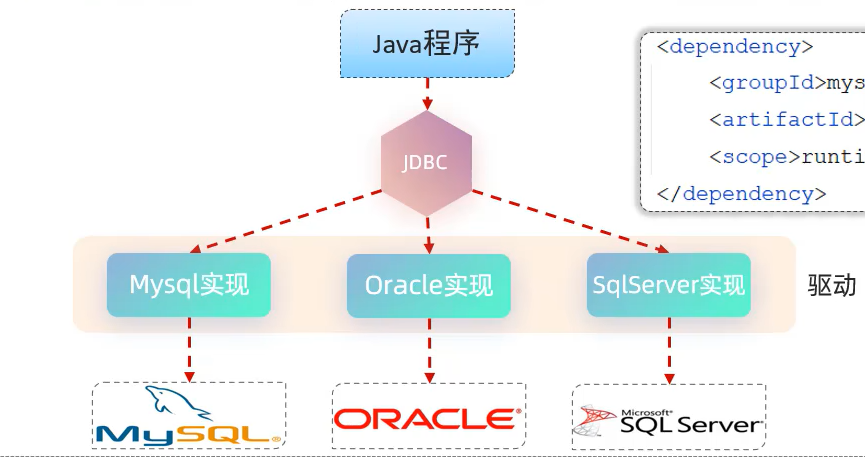
数据库连接池
- 数据库连接池是个容器,负责分配、管理数据库连接(Connection)
- 它允许应用程序重复使用一个现有的数据库连接,而不是再重新建立一个
- 释放空闲时间超过最大空闲时间的连接,来避免因为没有释放连接而引起的数据库连接遗漏
- 优势:
- 资源重用
- 提升系统响应速度
- 避免数据库连接遗漏
- 切换Druid数据库连接池
<!--方式一:pom.xml 添加依赖-->
<dependency>
<groupId>com.alibaba</groupId>
<artifactId>druid-spring-boot-starter</artifactId>
<version>1.2.8</version>
</dependency>// 方式二:application.properties
spring.datasource.druid.driver-class-name=com.mysql.cj.jdbc.Driver
spring.datasource.druid.url=jdbc:mysql://localhost:3306/mybatis
spring.datasource.druid.username=root
spring.datasource.druid.password=1234 - 接口:DataSource
- 产品:C3P0、DBCP、Druid、Hikari
lombok
- Lombok 是一个实用的 Java 类库,能通过注解的形式自动生成构造器、getter/setter、equals、hashcode、toString等方法,并可以自动化生成日志变量,简化java开发、提高效率。
- 添加依赖
<dependency>
<groupId>org.projectlombok</groupId>
<artifactId>lombok</artifactId>
</dependency>
 3. 注意事项: Lombok 会在��编译时,自动生成对应的 java 代码。我们使用 lombok 时,还需要安装一个 lombok 的插件(idea 自带)。
3. 注意事项: Lombok 会在��编译时,自动生成对应的 java 代码。我们使用 lombok 时,还需要安装一个 lombok 的插件(idea 自带)。
Mybatis 基础——增删改查
准备
- 准备数据库表 emp
- 创建一个新的 springboot 工程,选择引入对应的起步依赖( mybatis、mysql 驱动、lombok )
- application.properties 中引入数据库连接信息
spring.datasource.driver-class-name=com.mysql.cj.jdbc.Driver
spring.datasource.url=jdbc:mysql://localhost:3306/mybatis
spring.datasource.username=root
spring.datasource.password=1234 - 创建对应的实体类 Emp(实体类属性采用驼峰命名)
@Data
public class Emp {
private Integer id;
private String username;
private String password;
private String name;
private Short gender;
private String image;
private Short job;
private LocalDate entrydate;
private Integer deptId;
private LocalDateTime createTime;
private LocalDateTime updateTime;
} - 准备Mapper接口 EmpMapper
@Mapper
public interface EmpMapper {
}
删除
- SQL 语法:
delete from emp where id = 17; - 接口方法:
@Delete("delete from emp where id = #{id}")
public void delete(Integer id); - 注意事项: 如果 mapper 接口方法形参只有一个普通类型的参数,
#{…}里面的属性名可以随便写,如:#{id}、#{value}。 - 日志输出
- 可以在
application.properties中,打开 mybatis 的日志,并指定输出到控制台。
#指定mybatis输出日志的位置,输出控制台
mybatis.configuration.log-impl=org.apache.ibatis.logging.stdout.StdOutImpl - 可以在
- 预编译SQL,优势
- 性能更高,只用编译一次,更改 ? 内内容可以多次执行
- 更安全(防止SQL注入)
- SQL 注入: SQL 注入是通过操作输入的数据来修改事先定义好的SQL 语句,以达到执行代码对服务器进行攻击的方法。
占位符
#{…}- 执行 SQL 时,会将
#{…}替换为 ?,生成预编译 SQL,会自动设置参数值。 - 使用时机:参数传递,都使用
#{…}
- 执行 SQL 时,会将
${…}- 拼接 SQL。直接将参数拼接在 SQL 语句中,存在 SQL 注入问题。
- 使用时机:如果对表名、列表进行动态设置时使用。
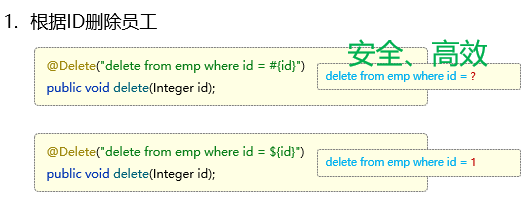
新增
- SQL 语句:
insert into emp(username, name, gender, image, job, entrydate, dept_id, create_time, update_time)
values ('songyuanqiao','宋远桥',1,'1.jpg',2,'2012-10-09',2,'2022-10-01 10:00:00','2022-10-01 10:00:00'); - 接口方法:
@Insert("insert into emp(username, name, gender, image, job, entrydate, dept_id, create_time, update_time) " +
"values(#{username}, #{name}, #{gender}, #{image}, #{job}, #{entrydate}, #{deptId}, #{createTime}, #{updateTime})")
public void insert(Emp emp);
新增(主键返回)
描述:在数据添加成功后,需要获取插入数据库数据的主键。
实现:
@Options(keyProperty = "id", useGeneratedKeys = true) // 会自动将生成的主键值,赋值给 emp 对象的 id 属性
@Insert("insert into emp(username, name, gender, image, job, entrydate, dept_id, create_time, update_time) " +
"values(#{username}, #{name}, #{gender}, #{image}, #{job}, #{entrydate}, #{deptId}, #{createTime}, #{updateTime})")
public void insert(Emp emp);
更新
- SQL语句(根据ID更新员工信息)
update emp set username = 'songdaxia', name = '宋大侠', gender = 1 , image = '1.jpg' , job = 2, entrydate = '2012-01-01', dept_id = 2, update_time = '2022-10-01 12:12:12' where id = 19; - 接口方法
@Update("update emp set username=#{username}, name=#{name}, gender=#{gender}, image=#{image}, job=#{job}, entrydate=#{entrydate}, dept_id=#{deptId}, update_time=#{updateTime} where id=#{id}")
public void update(Emp emp);
查询
- SQL 语句:
select * from emp - 接口方法
@Select("select * from emp where id = #{id}")
public Emp getById(Integer id); - 数据封装
- 实体类属性名 和 数据库表查询返回的字段名一致,mybatis 会自动封装。
- 如果实体类属性名 和 数据库表查询返回的字段名不一致,不能自动封装。
- 数据封装方法:
- 起别名: 在 SQL 语句中,对不一��样的列名起别名,别名和实体类属性名一样。 语法: 别名 属性名
@Select("select id, username, password, name, gender, image, job, entrydate, dept_id deptId, create_time createTime, update_time updateTime from emp where id = #{id} ")
public Emp getById(Integer id);- 手动结果映射: 通过 @Results及@Result 进行手动结果映射。
@Select("select * from emp where id = #{id}")
@Results({
@Result(column = "dept_id", property = "deptId"),
@Result(column = "create_time", property = "createTime"),
@Result(column = "update_time", property = "updateTime")})
public Emp getById(Integer id);- 开启驼峰命名: (推荐)如果字段名与属性名符合驼峰命名规则, mybatis 会自动通过驼峰命名规则映射。
#开启驼峰命名自动映射,即从数据库字段名 a_column 映射到Java 属性名 aColumn。
mybatis.configuration.map-underscore-to-camel-case=true
查询(条件查询)
- SQL 语法:
select * from emp where name like '%张%' and gender = 1 and entrydate between '2010-01-01' and '2020-01-01 ' order by update_time - 接口方法

- 参数名说明
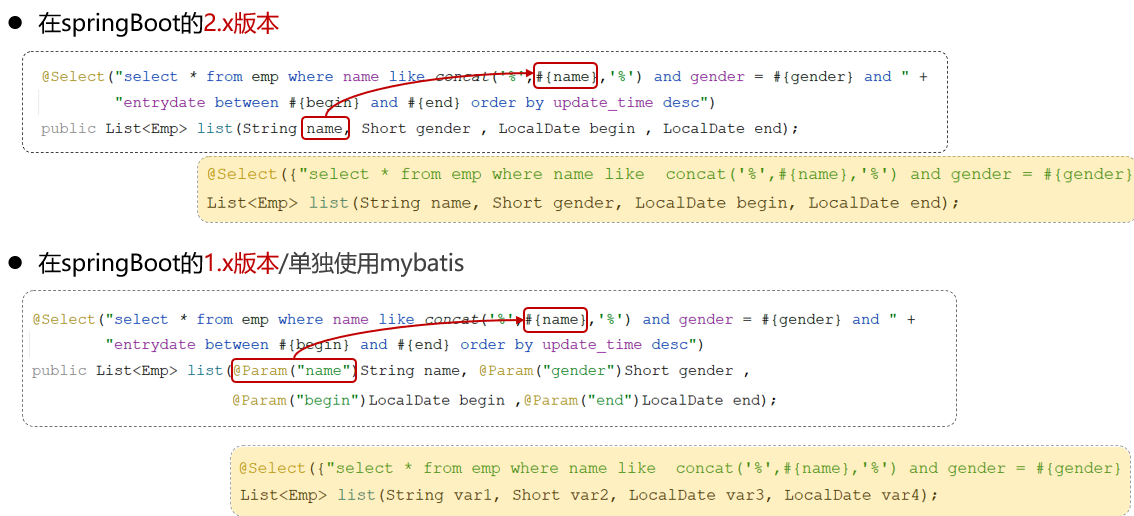
XML 映射文件
规范:
- XML 映射文件的名称与 Mapper 接口名称一致,并且将 XML 映射文件和 Mapper 接口放置在相同包下(同包同名)。
- XML 映射文件的 namespace 属性为 Mapper 接口全限定名一致。
- XML 映射文件中 sql 语句的 id 与 Mapper 接口中的方法名一致,并保持返回类型一致。
<select id=“abc” resultType=“com.itheima.pojo.Emp”>// 单条记录所封装的类型
- MybatisX 是一款基于 IDEA 的快速开发Mybatis的插件,为效率而生。
- 使用 Mybatis 的注解,主要是来完成一些简单的增删改查功能。如果需要实现复杂的 SQL 功能,建议使用 XML 来配置映射语句。
- 官方说明:https://mybatis.net.cn/getting-started.html
Mybatis 动态 SQL
动态 SQL
随着用户的输入或外部条件的变化而变化的 SQL 语句,我们称为 动态 SQL。
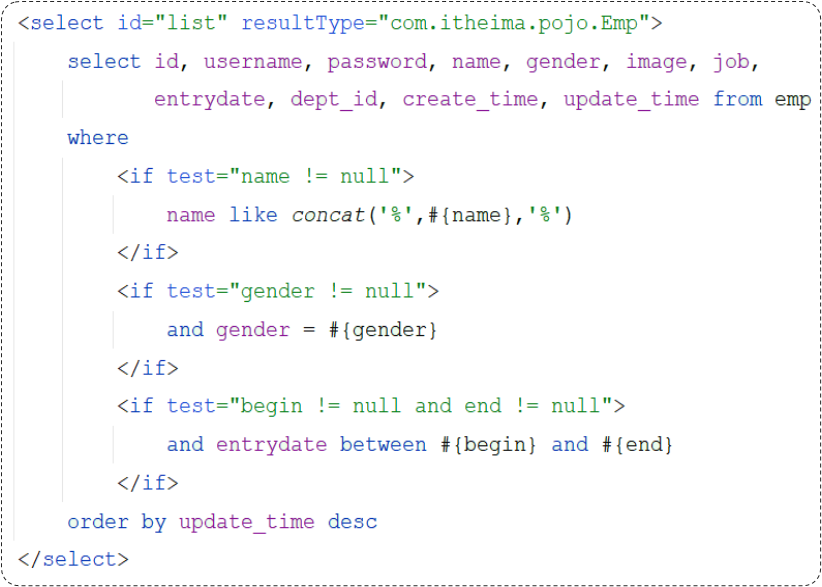
<if>
<if>:用于判断条件是��否成立。使用test属性进行条件判断,如果条件为true,则拼接SQL。<where>:where 元素只会在子元素有内容的情况下才插入where子句。而且会自动去除子句的开头的 AND 或 OR。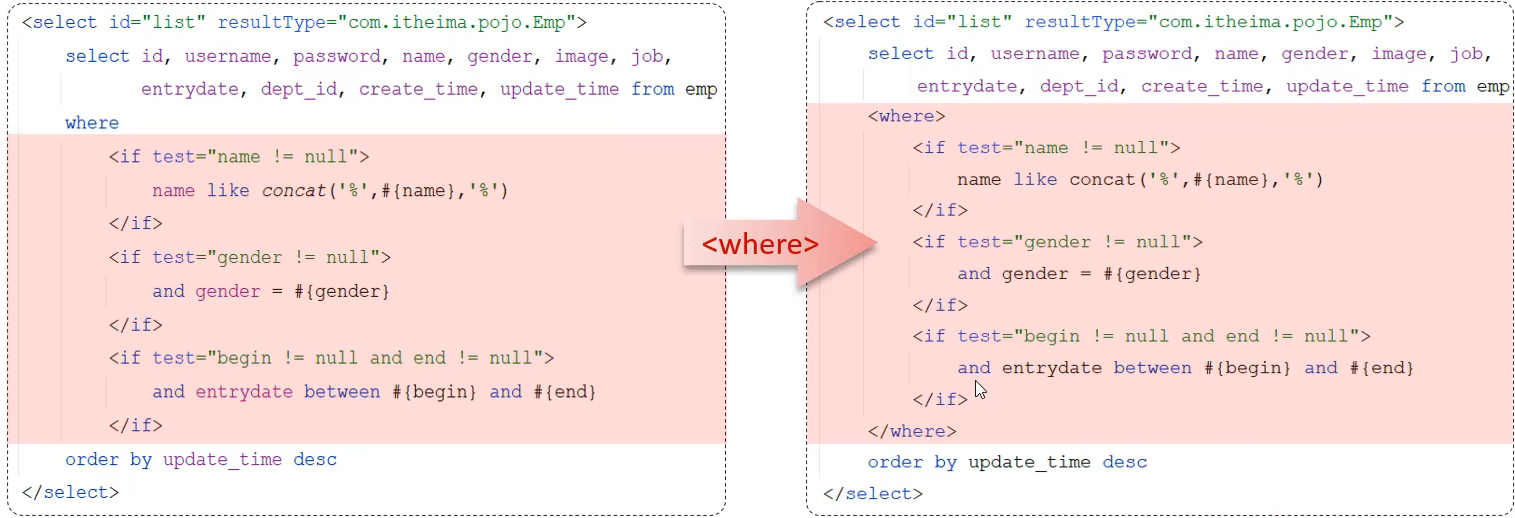
<set>: 动态地在行首插入 SET 关键字,并会删掉额外的逗号。(用在update语句中) ctr + alt + l 格式化 SQL 语句
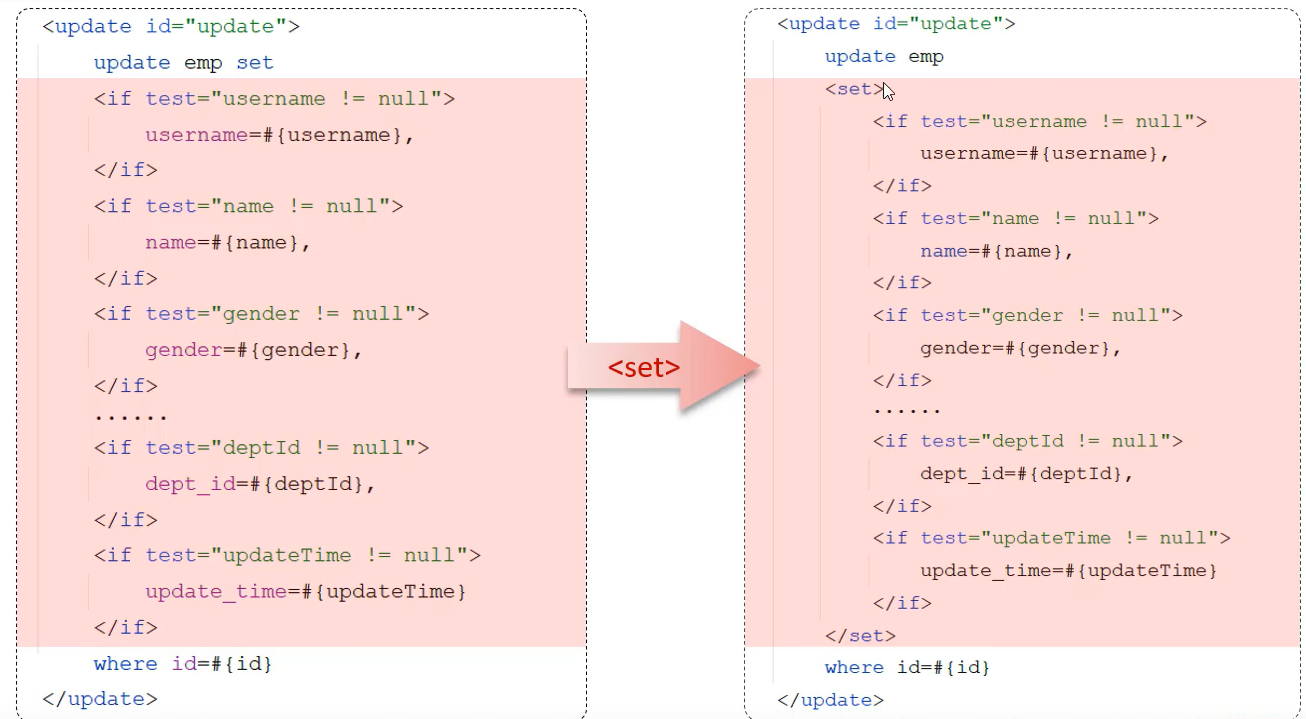
<foreach>
- SQL 语法:
delete from emp where id in (1,2,3); - 接口方法:
//批量删除
public void deleteByIds(List<Integer> ids); - XML 映射文件
<delete id="deleteByIds">
delete from emp where id in
<foreach collection="ids" item="id" separator="," open="(" close=")">
#{id}
</foreach>
</delete> - 属性
- collection:集合名称
- item:集合遍历出来的元素/项
- separator:每一次遍历使用的分隔符
- open:遍历开始前拼接的片段
- close:遍历结束后拼接的片段
<sql><include>
<sql>:定义可重用的 SQL 片段。<include>:通过属性 refid,指定包含的 sql 片段。